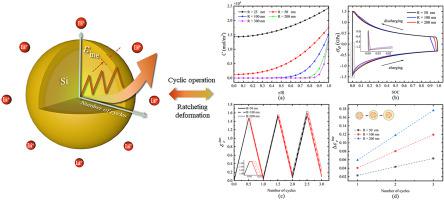Mechanics of Materials ( IF 3.9 ) Pub Date : 2021-09-10 , DOI: 10.1016/j.mechmat.2021.104062 Yutao Shi 1 , Li Weng 1 , Yudong Zhang 2 , Chengjun Xu 1 , Qilu Chen 2 , Bingbing Chen 2 , Jianqiu Zhou 1, 3 , Rui Cai 4

|
Evidences have accumulated that high capacity silicon electrode will expand/shrink dramatically during cyclic charging/discharging operation. In this process, the electrode may undergo elastic-inelastic deformation, and cyclic asymmetric behavior of tension and compression can naturally result in the electrode ratcheting deformation. In this paper, a chemo-mechanical semi-analytical model is established to describe the ratcheting behavior of the silicon particle electrode based on concentration-dependent material properties. The results show that inelastic deformation can reduce the rapid increase of the stresses and further reduce the possibility of surface crack. However, the accumulated irreversible inelastic strain may become one of the important factors for mechanical degradation and even electrode failure. The influence of hydrostatic stress on electrode ratcheting behavior is discussed in detail. It can decrease the concentration gradient and stress level, thereby reducing the inelastic region and ratcheting deformation, which will prolong the predicted lifetime of the electrode. The diffusion coefficient, particle size and the charging rate have also been investigated. The results reveal that ratcheting deformation may be decreased by the high diffusivity, the small particle size and slow charging strategy, which will improve the mechanical stability and capacity of the electrode. Meanwhile, interparticle contact may worsen the ratcheting deformation. Increasing the electrode porosity appropriately can provide space for silicon particles to expand, which may reduce the ratcheting deformation. The present work gives a new explanation for ratcheting deformation in silicon particle electrode and provides a theoretical basis for guiding one in designing next-generation high capacity lithium-ion batteries.
中文翻译:

循环充放电下硅粒子电极棘轮形变的化学力学分析
已有证据表明,高容量硅电极在循环充电/放电操作期间会急剧膨胀/收缩。在这个过程中,电极可能会发生弹性-非弹性变形,拉压的循环不对称行为自然会导致电极棘轮变形。在本文中,建立了化学机械半解析模型来描述基于浓度相关材料特性的硅颗粒电极的棘轮行为。结果表明,非弹性变形可以减少应力的快速增加,进一步降低表面裂纹的可能性。然而,累积的不可逆非弹性应变可能成为机械退化甚至电极失效的重要因素之一。详细讨论了静水应力对电极棘轮行为的影响。它可以降低浓度梯度和应力水平,从而减少非弹性区域和棘轮变形,从而延长电极的预期寿命。还研究了扩散系数、粒径和充电速率。结果表明,高扩散率、小粒径和缓慢充电策略可以减少棘轮变形,这将提高电极的机械稳定性和容量。同时,颗粒间接触可能会加剧棘轮变形。适当增加电极孔隙率可以为硅颗粒的膨胀提供空间,从而减少棘轮变形。



























 京公网安备 11010802027423号
京公网安备 11010802027423号